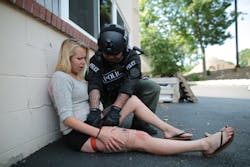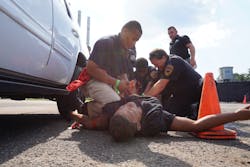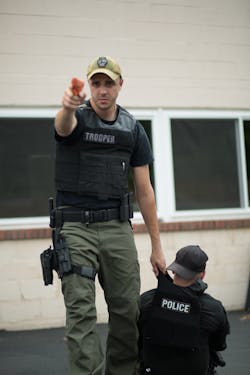Minimize Active Shooter Casualties Through Trauma Care
How do we do that?
The easiest method is to ensure that all responding officers are equipped with a few trauma treatment items including a tourniquet, a hemostatic agent and a pressure bandage. More is better, but so many as to be burdensome is counter-productive. Additionally, having these items on the officer’s person as he responds isn’t the only option. They can also be preplaced in schools in each classroom, in offices, in hallways and other strategic locations. When every officer goes through active shooter response training, the basic trauma care treatments such as applying a tourniquet, stuffing a penetrating wound with hemostatic gauze and applying a pressure dressing should be included.
What training is necessary?
What medical supplies are required?
Every officer should already have a tourniquet available for self-treatment. This is especially true when responding to any active shooter event as it behooves officers not to become another victim in need of saving. Officers are expected to treat themselves if it becomes necessary and they’re capable. They’re expected to either get back in the fight or extract themselves from the scene. In addition to that self-treatment tourniquet—which obviously can be used for someone else—an additional tourniquet would be a great idea. Hemostatic gauze for packing and/or wrapping wounds and pressure bandages to slow or contain bleeding already packed with hemostatic gauze would be good. That’s two tourniquets, two hemostatic gauzes and two pressure bandages per responding officer. Anything else beyond that is “icing on the cake.”
How do we locate them?
One of the biggest challenges in treating any casualty is finding out where the nearest supplies are, getting them, getting them back to where the casualty is and then treating the casualty. A “standard” location needs to be determined and enacted. While it would be awesome if the standard was set and followed nationwide, that’s next to impossible due to the number of law enforcement agencies there are, the areas they serve and the variations in patrol types from foot patrol to mounted on horseback. That said, at any given agency, the location of trauma care supplies should be standardized and enforced. If active shooter response kits are built, they should all include the same trauma care equipment, packed or stored the same way. In any given school district, if emergency care supplies are placed in classrooms, then the location of them should be standardized. The last thing we need to do is prolong the amount of time it takes to render aid simply because the supplies can’t be located in a timely fashion.
Who can have them?
Anyone. Everyone. If they’ve been suitably trained, no matter the source of the training, they should have access to the supplies. Losing a single life because someone was restricted from access to potentially life-saving supplies is unacceptable. Get them. Get the requisite training. Place them in a standard location or load out. Leverage the benefit to be gained in saving lives.
This article is part of a series of articles dedicated to responding to and prevention of active shooter events. Download and share the entire series here.



